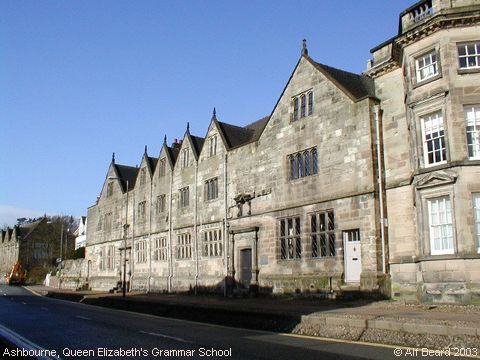Queen Elizabeth's Grammar School, Ashbourne
# The Ashbourne Free Grammar School was founded in 1585 under a charter granted by Elizabeth, Queen of England by the Will of Sir Thomas Cockayne, with William Bradburn Esq. and others. This building - the ‘Old School’ - was occupied in the recent past by boy pupils, and was where both boys' and girls' school meals were taken. The imposing shadow across the road is cast by ‘The Mansion’.[1] To mark the Quadcentenary (400th anniversary ) of the founding of the School, Her Majesty the Queen visited both The Green Road site and the Old School on 15th March 1985. A plaque to commemorate the visit was unveiled at the Old School. Two years later, in 1987, the school re-acquired the original Grammar School Seal. Past pupils, their friends and relations contributed towards the cost of buying back the ancient seal, which was discovered in the United States. One US resident even had an office whip-round! The seal, which is oval with pointed ends [is there a specific name for this shape?], shows Elizabeth I on the face, and the granting of the charter, together with a Latin inscription round the edge - granting a LIBERAE SCOLAE GRAMMATICALIS. The charter and seal together represent the beginning of education at Queen Elizabeth's. The school motto is ‘En Bon Espoyr’, and the school emblem is the three red cockerels (on a shield) of the Cockayne family, the School's founders. The Old School building is no longer in use by the School, which now has newer premises in The Green Road. It was offered for sale at auction on 18th December 1997, described as “probably the town's second most prominent building... second only to the Parish Church - St Oswald's”. A ‘For Sale’ notice in the Peak Advertiser in 1997 further related that: “Much of the stonework was completed by 1589 and the building was finally completed and opened in 1603, there having been some considerable delay owing to the shortage of carts to transport the roof timbers.”[2] The central school section is flanked at each end by residences which were intended originally for two schoolmasters. Samuel Johnson applied for the position of Under Master in 1732, but was rejected! In 1905, a plan to demolish the building was approved by the County Council of the day; however it was saved thanks to the intervention of the Derbyshire Archaeology Society, and it is now a Grade I Listed building. (Information provided by Rosemary Lockie) References
Image contributed by Alf Beard on 13th March 2003.
|
||
